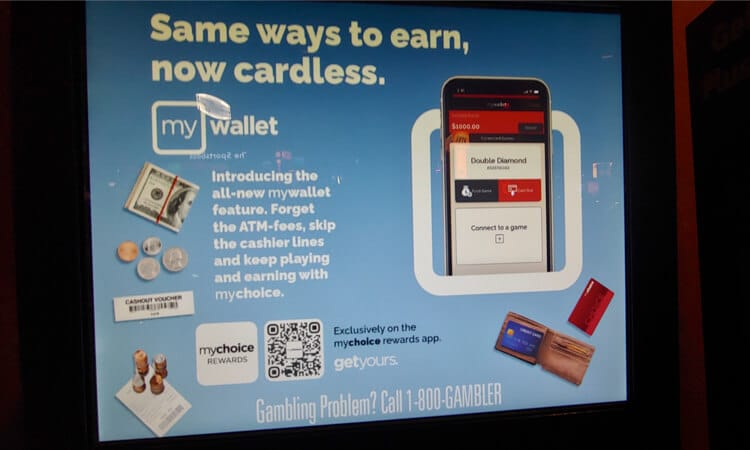Penn National Gaming has begun using three Pennsylvania casinos to promote its new “three C’s” conversion to cash-less, card-less, and contact-less gaming, which it touts as a key advance to attract a new generation of gamblers.
I’ve long had my own three C’s when it comes to any new technology: confused, confounded, and change-averse. There’s a reason this boomer much preferred The Flintstones to The Jetsons on Saturday mornings when growing up — I identified more closely with Fred’s and Barney’s lifestyle, which was easier to understand.
So I considered myself the perfect candidate to visit Penn National’s Meadows Racetrack & Casino to test out this idea that you no longer need cash to be a slots player — just a smartphone app. If I could master it, anyone can.
It’s supposed to work like this: You transfer funds from a bank card or account into a digital wallet connected to your casino loyalty card information, scan the app at a slot machine, send designated funds to the machine, play as long as desired, and when done you cash out any winnings or remaining funds by sending them back to the wallet — from which you can use them at the next machine you move to or also direct them back to your bank account.
Penn National began introducing the optional program, called “mywallet,” to its mychoice loyalty club members playing slots at the Meadows and at Hollywood Casino this summer. It is promoting it whole hog for guests playing table games as well as slots as its new Hollywood Casino York mini-casino, which opened Thursday.
Valley Forge Casino Resort is the only other Pennsylvania casino with similar technology thus far, using the BoydPay cashless system for slot machine play. Casino owner Boyd Gaming Corp. has introduced it in three other states besides Pennsylvania so far, with hopes to install it in the majority of its properties nationally by year’s end.
The millennials are the real target, but …
Of these cashless Pennsylvania casinos, the Meadows is the closest to me, and I perfectly fit that semi-rural Washington County venue’s core demographic — folks in their 50s and 60s.
That is not the target demographic of these digital wallet programs. Casinos are hoping to make themselves more attractive to people in their 20s and 30s who are used to paying for everything from coffee to gas to I don’t know what — a pallet of CBD products? — by scanning a QR code from their phone. Industry officials note the COVID-19 pandemic only increased the public’s aversion — including those older than millennials — to touching and exchanging bills that have been in the hands of untold numbers of other individuals, healthy or not.
With the new cashless systems, casino customers can also avoid the need to use ATMs, which contain some hefty fees to utilize in the gambling venues — typically more than $5 per transaction. That aspect doesn’t sound bad, particularly for someone whose “fourth C” is “cheap.”
So at home, I downloaded Penn National’s mychoice app to my Android phone to get started, linking it to my existing player account by entering my physical card’s ID number. An option shows up within the app to create a connected mywallet account, by providing personal information including Social Security number, driver’s license number, and date of birth. (Conspiracy theorists and privacy-fixated individuals are evidently not part of the target demographic.)
The app gave options to use credit or debit card numbers or bank account info to deliver a designated amount of funds to mywallet for future play. I chose $50 from a debit card to get started. And that’s where an unexpected message showed up: The transaction carried a $2.25 fee.
“By checking this box and clicking ‘submit,’ you agree to pay the ‘fee’ as part of the ‘total charge’ indicated above and you acknowledge additional fees imposed by your bank may be assessed.”
Sheesh, I thought part of the point was to avoid such fees. I could just bring $50 in my wallet — the real one — and slip it into the machine directly at no extra charge. I’m already down $2.25 before starting to gamble. Grumble.
Success! You did it! You’re a success!
Grousing aside, I’ll admit to a certain satisfaction — the kind a first-grader might take in spelling their full name correctly — when the app’s message read: “Funding success! $50 successfully added to your wallet.” It seemed to be complimenting me, perhaps as surprised as I was to have gotten this far. Who knew I was capable of such advanced participation in modern society?
That is when I also noticed under “account settings” in the app that there were options to limit myself on how much I could deposit in funds at any one time, or for a designated period of days. It is a feature the industry touts as the kind of self-enforced responsible gambling option unavailable to a slots player using cash. I have my own RG safety tool, however: I hate slots. This is all just a journalistic experiment.
And with that, I drive to the Meadows, phone in my pocket, real wallet empty, braced for action. The gaming floor there is huge, a big, broad, open space with more than 2,300 machines. I head for a corner far from the center of the action, so I might go unnoticed if fumbling around like an idiot.
I sit at a Cleopatra machine to play. I press the app on my phone, where the screen shows an icon resembling a slot machine. When I press that, it switches to the mywallet screen showing my $50 in available funds. I click on a box that says “connect to a game.” A new screen instructs me to hold the phone just in front of Cleopatra’s card reader. I do.
And … nothing. Other than this overly optimistic message on the phone:
“Move closer to the machine you want to play. Our app will prompt you to connect and you’ll be on your way to winning!”
Uh, no it won’t. It will just keep showing a spinning circle indicating it’s trying to do something, but to no effect. I move the phone around a bit in front of different parts of the machine, all with the phone very close. My new message:
“Oops! Connection issue. We’re having trouble finding a card reader to connect with. Would you like to try again?”
Well, I would if it was gonna work. Because I deliberately found myself a deep, dark corner of the Meadows, there’s no nearby slots attendant to ask for help. I move to a different machine nearby, Wolf Run, to try my luck … or patience.
Wolf Run proves how to do it, and even win
For whatever reason, holding up the phone this time in the same way as before, I get a different message immediately: “Connection.” The app then asks if I would like to transfer funds from my digital wallet to the game and how much. I type in a request to transfer $15. It asks if I’m sure. Well, duh.
And again comes the high praise: “Success! You have added $15 to the balance of Wolf Run slot #101966.”
And so the funds are in the machine and I start playing, while nearby there are all these other poor players using cash and cards and those umbilical cords attached to their cards and everything else that is so, well, just 2020. I feel sorry for them and their Neanderthal ways.
And then after a series of losing spins on this penny machine that costs $2 to play at max credits, I hit a nice win that gets me ahead $2.50 for the session. Well, there’s something to cash out. It’s partly to preserve my winnings, but also, to serve purposes of our test.
Under mywallet on the phone, I see one of the options is “card out.” Not everything in this app is immediately intuitive, but I’m guessing that’s what I want. When I click, it asks, “Are you sure you wish to card out of this machine?”
Well, I dunno, I guess I could keep playing and lose what amount I have in there. Is that what you want, mychoice/mywallet app? Is that why you’re hesitating? I click yes, yet again telling it to card me out.
“You’ve been cashed out of Wolf Run slot #101966 $17.50. The amount above has been transferred to your digital wallet.”
And I see in the app that my available funds have risen to $52.50 from the original $50. Taking into account that original $2.25 transaction fee, I’m up 25 cents utilizing the most modern slots technology known to man. Sweet!
Wait, not so fast, you early adopter, you
I could have ended the article at this point as a real kind of good-news story for all concerned — me, the Meadows, Penn National, societal futurists, whomever — if not for the fact that I then walked over to an Ultimate X poker machine and got no connection again. I switch to a Quick Hit Platinum machine. No connection.
The York mini-casino apparently has an “activation center” where trained employees assist guests in creating and using their apps. The Meadows does not have that. I go to a nearby cashier’s cage to ask if I’m doing anything wrong or if anyone else has reported such problems or if there’s anyone to help me.
A cashier confers with a supervisor. They’re a bit dumbfounded. They call the slots department to send someone over.
“We don’t have a lot of experience with this yet,” the supervisor confides.
When a nice, concerned slots attendant shows up, he’s also a bit perplexed. No one else has reported such troubles, he said, but he guessed that was only because so few customers at the Meadows have tried the technology in the month it has been in place.
“I’ve noticed maybe three people trying to use it,” the attendant informs.
We walk to a nearby Dancing Drums machine so I can show him my connectivity problems. A female slots attendant joins us. I go through the whole phone charade for them to witness. The woman suggests I might hold the phone differently. Nothing happens.
I ask if they’ve had training on the system and how to help patrons with it. They both pull folded-up 8-by-11 sheets of paper out of their pockets.
“This is our training,” the fellow says, unrumpling the paper before calling the slots manager on duty.
So now the manager, plus the two attendants, is there with me at Dancing Drums so he can observe how erratic this new-fangled stuff is. And in my app I push the slots icon and the “connect to a game” box and put the phone next to the card reader … and it works. It connects instantly this time. No one understands why.
Convenience sounds great, but connections critical
After navigating mychoice/mywallet through Dancing Drums and two additional machines, I still had more than $50 showing in the account, so I clicked on a button option to “withdraw funds.” I wanted my original stake back.
The glitch there was that though I had deposited $50 initially by debit card, it wanted to transfer money back to me only by bank accounting routing — not through the debit card number. When I followed its prompts and put in my banking numbers, mywallet said: “$50 successfully initiated to be deposited to your ACH account.” The second glitch is the transfer is not instantaneous. The funds showed up in my account at the end of the next business day.
In the end, things worked out fine for this dinosaur. There’s certainly a convenience factor to never having to worry about paper tickets coming out of machines, and to carry them and cards around to be placed in another machine, and then ultimately to convert them to real money in another machine.
For the casino, having customers use their phones reduces the workload involved in collecting and counting cash inside the machines, addressing problems that arise in paper ticket dispensing, and so forth.
On the other hand, there are inevitably going to be people who cling to the old cash methods of gaming, and the casinos know they will have to be accommodated. (Casino operators have declined to reveal information on what percentage of customers are utilizing the cashless technology in venues where it is available.)
But one thing’s certain, for the early adopters: If the technology isn’t in place to ensure that every phone app held to a machine automatically connects to it instantaneously, it will be costly in both customer satisfaction and revenue.
Epilogue: This 63-year-old completed his transformation to the 21st century by using his credits on the mychoice app to pay for a hamburger combo in the Meadows food court. He got his food, but only after the cashier his age ran into difficulties trying to scan his phone app and shouted to her younger co-worker: “Hey, Justin, you ever use one of these things before?”






